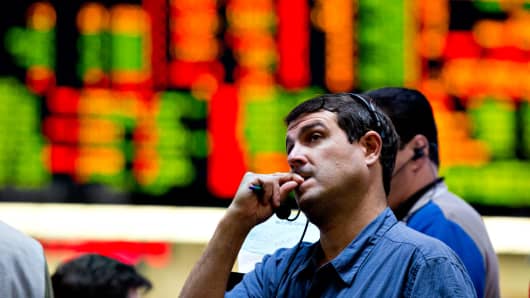Federal Reserve officials are increasingly concerned about the coming “fiscal cliff,” putting it on par with the European financial crisis and the housing market as among the biggest potential threats for the U.S. economy.
And there appears to be a debate about what the Fedcould or should do to counter the negative effects of the coming decline in federal spending and tax hikes.
At the heart of that debate is frustration within the central bank that Congress and the administration are relying too heavily on monetary policy to kick start the economy and keep the recovery going.
Chicago Fed President Charles Evans, in remarks last week, noted that fiscal stimulus is already wearing off.
“The cliff at the end of this year is just that writ large. Whether or not calmer heads will prevail and avoid this or do something useful, you know that's about as big an uncertainty as I can imagine anybody facing,” Evans said at the Milken Conference.
The August debt ceiling debacle is fresh in the Fed’s mind, with Fed Chairman Ben Bernanke several times saying that threat of a default by the U.S. government created entirely avoidable market fears and economic weakness.
That’s why Atlanta Fed President Dennis Lockhart, also at last week’s Milken conference, refused to label the fiscal cliff “an economic shock.” Instead, he called it “perfectly predictable” and threw the onus for solving it on the fiscal authorities.
“Congress and the administration understand that the perception is growing that if a transition isn't engineered that works well, that you're going to end up with a lot of mojo taken out of the economy in a very brief period of time,” he said.
Lockhart wouldn't rule out using Fed policy to counteract the effects of a decline in government spending, but it clearly wasn’t his first choice. Evans, among the leading voices on the Fed for more stimulus, said it was another reason the Fed should ease.
But Fed Chairman Bernanke warned at his press conference two weeks ago that the size of the fiscal cliff is so large that “I think (there’s) absolutely no chance that the Federal Reserve could or would have any ability whatsoever to offset that effect on the economy. So as I have said many times before, it’s imperative for Congress to give us a fiscal policy.”
Even if the Fed could partially offset the weakness, there seems to be little appetite by some members of the rate-setting Federal Open Market Committee to do so. Richmond Fed President Jeff Lacker, one of the Fed’s hawks, is actually in agreement with Bernanke that too much reliance has been placed on Fed policy to stimulate the economy.
Last week he noted, “The impediments to growth that I have discussed today are all quite real. That is, they are factors for which monetary policy is not the remedy. Monetary policy will not occupy vacant homes or give unemployed workers the skills to fill vacant jobs or reduce regulatory and fiscal uncertainty.”
Bernanke is in a complicated negotiating position relative to Congress. On the one hand, he is not as extreme as Lacker in ruling out further quantitative easing . In fact, he’s been pretty clear that the Fed would act if the economy weakens. On the other hand, what if that weakness comes from fiscal policy? Assuring markets that the Fed would act could also take the heat off of Congress to deal with the fiscal situation.
The “fiscal cliff” is shorthand for a series of stimulus programs and tax cuts that will expire toward the end of the year. It includes the planned wind down of extended unemployment benefits, the expiration of the Bush tax cuts and payroll tax cuts and the beginning of sequestration — the automatic spending cuts that take effect as a result of last year’s 11th hour budget deal. In total, it could mean up to a $500 billion hit to the economy.
Wall Street economists are divided over how real the threat is. Some believe politicians will work out a deal to keep federal spending from falling over a cliff as they have in the past; others worry the decline in spending could undermine confidence and cause the private sector to pullback as it did in August.
There are splits as well along political lines with one side arguing that the government needs to start someplace to reduce its trillion-dollar annual deficits and shouldn’t keep putting off the day of deficit reckoning. This group also argues that a large part of economic weakness stems from uncertainty over how and when the deficit will be reduced and from government spending crowding out the private sector.
From the other side, liberal economists contend that the initial stimulus spending by the government was never sufficient to kick start the economy and that the government can and should keep running high deficits to prop up the economy until the private sector takes the reins.
The Fed and Bernanke have waded only gently into that argument, urging Congress to put in place a long-term deficit reduction plan, but be careful not to hobble the economy with Draconian near-term cuts. Bernanke, however, has not been shy about letting his frustration be known over what happened in August.
But there’s only so far that the Fed will go publicly. It even drew criticism when it involved itself in the housing debate. Some politicians saw a paper the Fed published with a series of actions the government could take to fix housing as inappropriate meddling in fiscal affairs.
It’s not hard to imagine that the Fed would likely be concerned over temporary fixes that pushed the can down the road, avoiding the immediate threat but adding to uncertainty.




